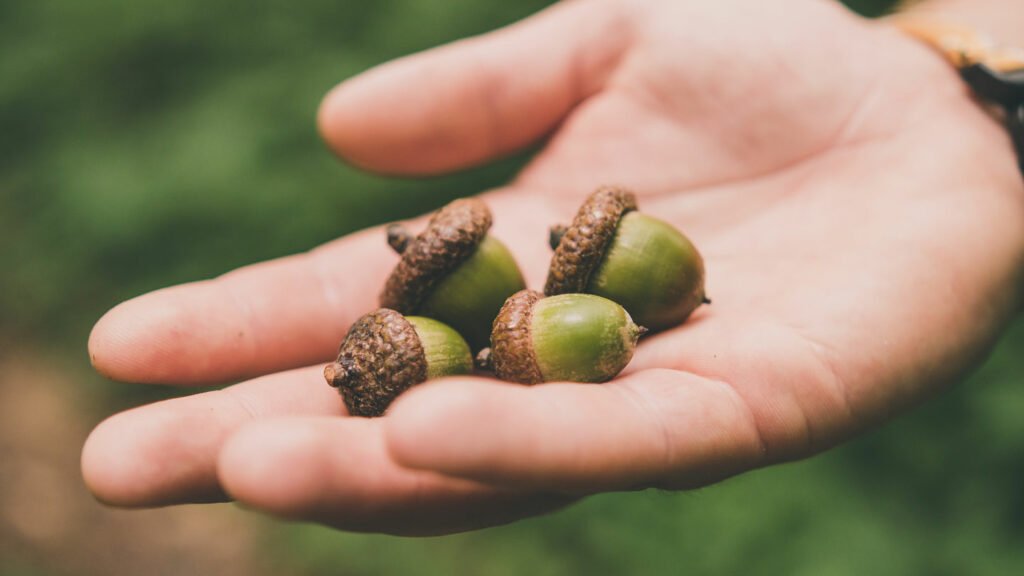Inside the far-reaching material of nature, oak seeds arise as inconspicuous heroes, recounting a nuanced story of stupendous oak trees and the multifaceted trap of life they support.
Beyond their biological capability, these genuine parts represent the commencement of new life, winding around together the sensitive strings of biodiversity.
You should leave on an excursion crossing the domains of environmental elements, oak tree wellbeing, and the sensitive equilibrium that nature carefully keeps up with. So, continue reading before you look for when do acorns start falling.
Understanding The Natural Process
The dazzling adventure of little oak seeds starts with the ethereal flowering of oak trees, denoting the initiation of their perplexing regenerative cycle. To understand the nuances of little oak seed creation, one should dig into the complexities of this natural movement.
Little oak seeds, apparently unnoticeable, act as the imperative connection among pollination and the development of tough saplings, embodying the beginning of the oak tree’s life cycle.
Every oak seed, an expected harbinger of life, conveys the hereditary outline of the powerful oak it tries to turn into. This perplexing dance among dust and shame makes way for a progression of changes, finishing in the humble yet strong little oak seed.
Environmental Influences On Acorn Size

Environment, a mind-blowing orchestrator, carefully shapes the size of oak seeds. Temperature varieties and precipitation designs engrave their permanent mark, making the novel components of these seeds.
All the while, the piece of the soil, a frequently ignored teammate, gives unmistakable characteristics to the oak seeds as the strong oaks draw food from the earth underneath.
In the theater of nature, the environment expects the job of both craftsman and chief, arranging the circumstances that impact oak seed advancement.
Hotter temperatures during the flowering time frame encourage the development of bigger oak seeds, while changes in precipitation influence their general size and feasibility.
Tree Health And Small Acorn Production

The elements of oak seeds stand as quiet tributes to the age and imperativeness of oak trees. More youthful trees, in the delicate phases of development, will generally create more modest oak seeds, while their respected partners yield seeds of strong height.
Simultaneously, the wellbeing of these arboreal watchmen, defenseless to the murmurs of diseases and the subtle interruption of pests, assumes an essential part in deciding the size and practicality of the oak seeds they bear.
Understanding and alleviating these factors and knowing oak tree dropping small acorns in summer are fundamental for cultivating the circumstances helpful for the development of vigorous oak seeds.
Human Interference And Small Acorn Occurrence
In the contemporary embroidery of nature, human undertakings cast a significant shadow upon the territories of oak trees. Perceiving and relieving these anthropogenic impacts are vital for protecting the uprightness of oak environments.
These changes resound through environments, influencing the size of oak seeds as well as the all-encompassing soundness of oak trees and the multifaceted interconnectedness of life.
Human impedance acquaints a complicated layer with the unpredictable dance of oak seed creation. Urbanization adjusts the microclimate, influencing the circumstances important for ideal oak seed advancement.
Ecological Significance Of Small Acorns

Underneath the rambling overhangs of strong oaks, little oak seeds assume a crucial part, frequently overshadowed by the magnificence of their environmental factors.
Filling in as essential food for different untamed life, these little seeds add to the powerful movement of environments. Protecting the fluctuated sizes of oak seeds unfurls significant ramifications for preservation, defending the strength of oak trees as well as the fragile woven artwork of life they support.
Their accessibility impacts the populace elements of these species, making complex biological connections. A variety of oak seed sizes guarantees a versatile environment, supporting a wide scope of fauna and keeping up with the fragile equilibrium of nature.
Conclusion
Interpreting the mystery behind little oak seeds’ plunge unwinds a charming story unpredictably woven into the texture of the natural world.
Their size, a demonstration of the oak tree’s regenerative excursion, reflects the orchestra of environmental subtleties, soil elements, tree wellbeing, and the inconspicuous intercessions of human exercises.
As overseers of the climate, perceiving and treasuring these complexities becomes basic for cultivating flourishing oak tree biological systems and maintaining the fragile balance of our common natural legacy.


